Introduction
Eating quality, including tenderness, flavor, and juiciness, is a very important factor in consumer choices of meat (Wood et al., 2004). Among them, tenderness is considered the most important factor affecting consumer satisfaction (Miller et al., 2001). Therefore, various studies have been conducted regarding the factors affecting meat tenderness and means to improve tenderness (Bekhit et al., 2014). Next, the flavor of meat is also considered to be an indispensable factor for the consumer, and can be determined chemically by the combination of taste-related and volatile odor compounds (Aaslyng et al., 2017). Although juiciness is also an important factor, research involving this parameter has been relatively overlooked compared to tenderness and flavor (Bertram et al., 2005).
Consumers prefer juicier beef steaks. Moisture content, intramuscular fat, pH, water holding capacity (WHC), concentration of glycogen, rearing environment, core temperature and cooking method affect the juiciness of beef steak (Aaslyng et al., 2003). Pathare and Roskilly (2016) demonstrated that the cooking method is the most important factor influencing juiciness of meat among the effectors.
Searing is a technique of cooking food surfaces at high temperature until a brown crust is formed. In order to obtain a desirable brown crust, the meat surface temperature must exceed 150°C, and water is evaporated from the surface at this temperature (Locker and Daines, 1974). It has been believed for centuries that the crust can keep the juice of the steak (Beard and Callvert, 2001). Later studies similarly reported that the searing cooking method seals the surface and reduces moisture, lipids, and cooking loss from the steak by forming a crust on the steak surface (Kerth et al., 2003).
In contrast, McGee (2007) reported that the crust formed on the meat surface by searing was not waterproof. The cooking loss of meat was only proportional to the cooking temperature. For example, the cooking loss was approximately 40% when cooked at 80°C for 30 min, while this value increased to around 50% when cooked at 100°C for the same time (Vasanthi et al., 2007). Similarly, Locker and Daines (1974) reported that the cooking loss of un-seared beef samples cooked at 80°C for 40 min was 27.5±2.3%, while the cooking loss of beef samples additionally seared at 193°C for 1 min was 30.8±1.1%. Another study showed that searing did not affect the juiciness of the meat, but only improved flavor through the Maillard reaction and browning (Barber and Broz, 2011). As indicated above, the effect of searing on meat quality, especially juiciness, is still controversial. Therefore, the objective of this study was to evaluate the effects of searing on sensory and physicochemical parameters of beef steak, including juiciness.
Materials and Methods
Imported frozen strip loins of beef, sliced to 5 cm thickness, were obtained from a domestic food market and cut into 7×12 cm2 sections weighing 400±10 g. Then, samples were thawed in a refrigerator at 4°C for 24 h before cooking. Beef samples were randomly divided into two groups. One group was used for oven cooking and the other group was used for searing cooking. The whole experiment was replicated thrice using different carcasses with two observations per replication.
Beef samples for oven cooking were placed in a 180°C preheated oven (MA324DTN, LG electronics, Seoul, Korea) and were flipped over when the internal temperature reached 40°C, then cooked until the meat attained 60°C internally, which took 49±3 min. On the other hand, the searing cooking group was cooked in a 180°C preheated oven (MA324DTN, LG electronics) until the internal temperature reached 35°C (without flipping), then the whole surface was uniformly cooked on a pre-heated pan (250±5°C) until the internal temperature reached 60°C. The time required for this treatment was 42±3 min. Therefore, the average heating rates of oven cooking and searing cooking were 1.23 and 1.43°C/min, respectively. Internal and surface temperatures of beef samples were measured using a digital thermometer (TM-747DU, Tenmars Electronics Co., Ltd., Taipei, Taiwan) and an infrared thermometer (ST-101, Sincon, Bucheon, Korea), respectively.
Prepared samples were cut into slices (40×20×5 mm3), placed on a white disposable dish with randomly selected 3-digit numbers, and presented to the sensory evaluation panelists. To perform the sensory evaluation, ten trained panelists who had at least a year of previous experience in meat sensory evaluation were selected and previously trained over three sessions with a standard oven-cooked beef steak. For the descriptive sensory analysis, the strength of overall flavor, roasted meat flavor, bloody taste, umami taste, redness, juiciness, and tenderness were measured using a 9-point scale (1, very weak; and 9, very strong). The sensory evaluation was conducted over three independent sessions at different times. Sensory evaluation was performed after obtaining approval from the Institutional Review Board (IRB) in Seoul National University (IRB No. 1910/002-011).
The water content of cooked beef samples was measured by dividing them into three different parts: whole, outside, and inside to ascertain the searing effect in detail (Fig. 1). Firstly, the cooked beef steak was halved and one half (126–199 g) was chopped to measure the whole water content. Thereafter, the remaining half was sliced and the outermost layer (3 g) and the central part (3 g) were used to measure outside and inside water content, respectively. Each sample was placed on an aluminum dish and measured after atmospheric pressure heat drying at 105°C for 18 h (AOAC, 2006).
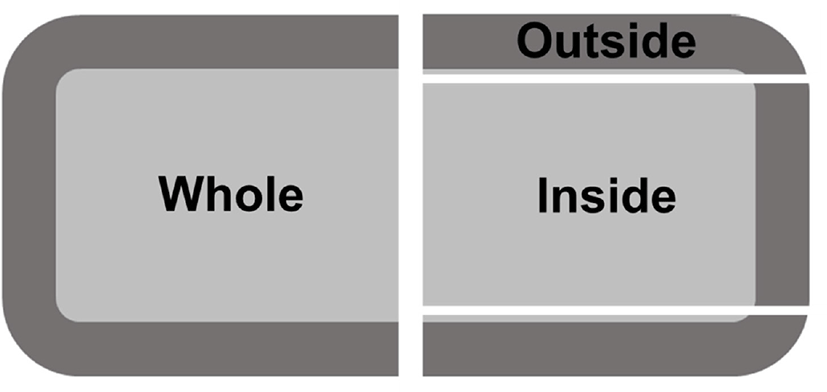
Beef (400±10 g) was cooked until the internal temperature reached 60°C according to each cooking method, and after cooling at 20°C for 1 h, cooking loss was measured. The sample cooking loss was calculated using the following formula.
After the beef was cooked and cooled to approximately 20°C, the outside of the steak was assayed to determine the surface color. The inside color was visualized by internal cross-section after cutting the steak. The Hunter color values CIE L* (+lightness, −Cdarkness), CIE a* (+redness, °Cgreenness), and CIE b* (+yellowness, −blueness) of cooked beef surfaces and inside color were determined with a colorimeter (CM-5, Konica Minolta Sensing Inc., Osaka, Japan). The instrument was calibrated using a black and white plate standard (CM-A210, Konica Minolta Sensing Inc., Osaka, Japan).
Reducing sugar levels were determined using a modification of the procedures of the dinitrosalicylic acid (DNS) method (Lee et al., 2019). Each beef sample (1 g) was blended (1,130×g for 30 s) with 5 mL of 80% ethanol (50°C) using a homogenizer (T10 basic, Ika Works, Staufen, Germany). Then, samples were filtered through filter paper (No. 1, Whatman International Ltd., Maidstone, UK) after centrifugation (2,265×g for 10 min; Continent 512R, Hanil Co., Ltd., Incheon, Korea). After adding 80% ethanol (50°C) once more, it was centrifuged (2,265×g for 10 min). The samples were filtered through a filter paper (No. 1, Whatman International Ltd.), and concentrated with nitrogen gas (99.99% purity) at room temperature. The reducing sugar content of meat was determined using supernatant of the concentrated sample with 2 mL of added distilled water after centrifugation (10,000×g for 10 min; HM-150IV, Hanil Co., Ltd., Inchen, Korea). DNS reagent (2 mL) was added to 1 mL of the extracted sample, and the mixture was heated in a water bath at 90°C for 15 minutes, cooled, and then optical density was measured at 550 nm using a spectrophotometer (X-ma 3100, Human Co. Ltd., Seoul, Korea). The reducing sugar content was quantified using a standard curve with glucose (Sigma-Aldrich, St. Louis, MO, USA) as a reference material.
MRPs were measured by following the method of Ajandouz et al. (2001). The sample (1 g) was homogenized (3,620×g for 30 s; T10 basic, Ika Works) and diluted 30-fold with distilled water. MRPs were determined at 290 nm and 420 nm using a spectrophotometer (X-ma 3100, Human Co. Ltd.). The aqueous intermediate product of the Maillard reaction was measured at 290 nm, and the water-soluble brown color intensity was measured at 420 nm.
Statistical analysis was determined by Student’s t-test and one-way ANOVA with a general linear model procedure using SAS program version 9.4 (SAS Institute Inc., Cary, NC, USA). Statistical analysis was performed using Tukey’s multiple test method, and the results were expressed as means and standard deviation.
Results and Discussion
Beard and Callvert (2001) described in their cookbook that searing cooking is a way to cook food quickly at high temperature and to make steak juicy. Similarly, in ‘The Joy of Grilling’, searing is described as a method to put juice inside the meat (Famularo, 1991). Wall et al. (2019) reported that the crust formed around outermost layer of beef steak prevented water evaporation and presented a higher juiciness score. However, they failed to deliver any possible reason or supportive data. No differences in juiciness were observed by descriptive sensory evaluation between two cooking methods in this study (Table 1).
The juiciness of cooked beef is affected not only by the cooking method, but also by final core temperature. When the M. longissimus dorsi was cooked by the same cooking method, the juiciness score was more than 8 points out of 15 when the final core temperature was 65°C, but it was below 6 points when it was cooked until a core temperature of 80°C (Bejerholm and Aaslyng, 2004). In addition, Drey et al. (2018) observed that juiciness decreased when degrees of doneness increased. In this study, the final internal temperature of the beef was set to be the same. Therefore, our result indicates that cooking method used in this study (searing- vs. oven-cooking) has no effect on juiciness of beef steak (Table 1).
In addition, no difference in tenderness was found for the cooking method. Similarly, Rodas-Gonzalez et al. (2015) found no significant difference in overall tenderness despite different searing time, searing temperature, and cooking temperature. The initial tenderness of the semimembranosus with the searing times of 0, 10, 20, and 30 min was 5.85, 5.94, 5.79, and 5.75, and overall tenderness was 5.81, 6.04, 5.82, and 5.74, respectively. Longissimus lumborum also exhibited similar patterns in their study (Rodas-Gonzalez et al., 2015).
However, scores for overall flavor and roasted meat flavor of the steak were higher in the searing cooking group. In fact, the sensory score for juiciness was not correlated to flavor (Bejerholm and Aaslyng, 2004). In a study by Wall et al. (2019), the roasted flavor score increased significantly when the cooking temperature was increased, but there was no difference in juiciness. The higher score in flavor would be due to the Maillard reaction, which is the reaction of amine groups of free amino acids with the carbonyl group of reducing sugars (Martins et al., 2000). Cooking meat at high temperature increases the Maillard reaction and increases meaty and roasted aromas in terms of sensory properties (Liu et al., 2015). In this study, searing-cooked steaks were seared at 250°C, which was approximately 70°C higher than oven-cooked steaks and may cause more Maillard reaction on the surface.
Intensity of color and taste did not differ regardless of cooking method. Thus, we conducted a further experiment to determine the cause of the unchanged juiciness score and the improved flavor score.
Juiciness of eating quality consists of two steps, an initial moist impression when biting the food, and a continuous water release during chewing of the meat, both of which stimulate the flow of saliva (McGee, 2007). Therefore, juiciness of cooked beef steaks is closely related to moisture content and cooking loss (Safari et al., 2001). As such, juiciness evaluated by sensory analysis was decreased when water loss during steak cooking was increased (Warner, 2017).
In our study, no significant difference in the moisture content of the whole, outside, and inside steak between the oven and searing cooking treatment was observed (Table 2). Water content in the searing treatment was the highest for inside, followed by whole, and lowest for outside. Cooking loss of oven- and searing-cooked beef were 23.68% and 23.82%, respectively, with no significant difference (Fig. 2). Similarly, Beard and Callvert (2011) reported that searing cooking did not affect the cooking loss of beef. In contrast, the cooking loss and moisture loss during slicing of Longissimus lumborum decreased with searing when compared to those without searing. Further, the moisture content of beef samples and the sensory evaluation scores were higher after searing (Rodas-Gonzalez et al., 2015). Shubert (2016) observed that searing the surface of the steak prevents moisture evaporation from inside the steak. However, in the present study, searing did not affect the juiciness of beef steak when the results of moisture content and cooking loss are considered.
| Part | Cooking method1) | |
|---|---|---|
| Oven | Searing | |
| Whole | 63.08±2.34 | 63.26±1.18ab |
| Outside | 63.83±1.20 | 61.09±1.44b |
| Inside | 65.88±1.69 | 66.75±2.61a |
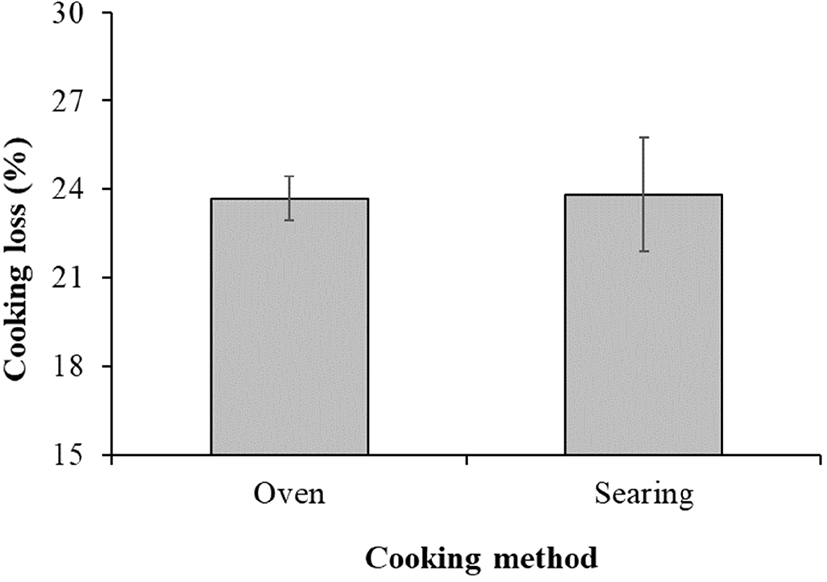
Surface color was changed following searing, the searing-cooked steak was generally darker in color and more brown-colored crust was formed (Fig. 3). The brown color of steak was the result of Maillard reaction and caramelization, which are non-enzymatic browning reactions (Zhang et al., 2015). Caramelization is induced when a sugar is dry-heated at high temperatures (Nagai et al., 2018). Both caramelization and Maillard reactions affect not only the color of the food, but also the aroma and flavor (Hong and Betti, 2016). The color change of the outer layer was more apparent when the internal cross-sectional area of the steak was examined (Fig. 3). A brown-colored band was formed on the outermost side of the searing-cooked steak. As expected, the surface of searing-cooked steak had the significantly lower lightness (CIE L*), redness (CIE a*), and yellowness (CIE b*) values (Table 3). The CIE L*, CIE a*, and CIE b* values of the steak decreased as the cooking temperature increased (Sikes and Tume, 2014). There was no significant difference in the internal color values between the oven- and the searing-cooked samples.
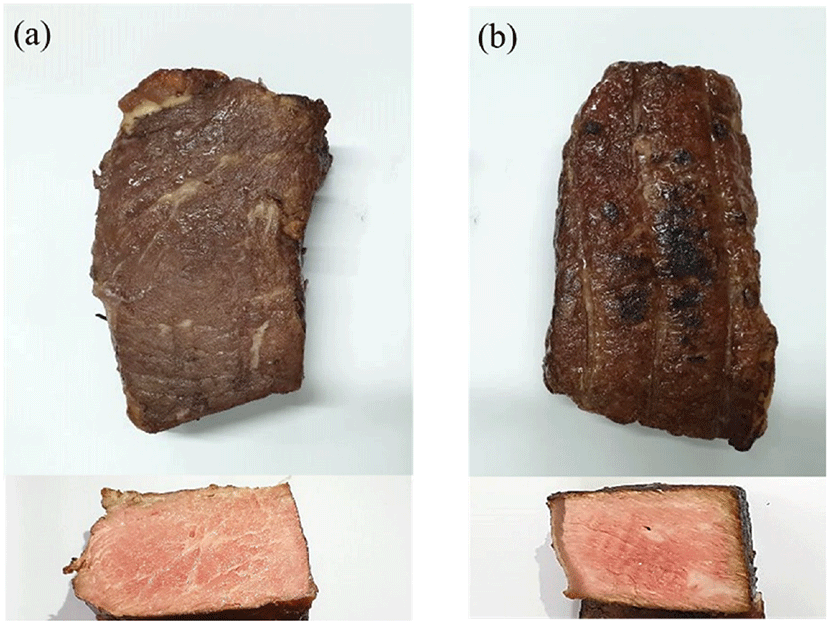
Reducing sugar content of the searing-cooked steak was 1.71 mM (Fig. 4), and significantly lower than that of 2.53 mM in oven-cooked steak (p<0.05). Reducing sugars on the surface of the searing-cooked steak are expected to be utilized in the Maillard reaction, in which the reducing sugar is reacted with nitrogen compounds in food ingredients through rapid, hot, dry heat treatment to form brown pigments and aromatic compounds (Park et al., 2000). As the Maillard reaction progressed, the reducing sugar content of chicken meat jerky decreased (Wongwiwat and Wattanachant, 2015). Similarly, the content of reducing sugar in chestnut was 2.06% before cooking, but decreased to 1.15% after boiling at 100°C and decreased to 0.67% when roasted at 200°C (Li et al., 2016). Also, when goat meat was cooked at 80°C, reducing sugars such as glucose (186 mg/100 g) and fructose (73.1 mg/100 g) in raw meat were diminished to 67 mg/100 g and 24.7 mg/100 g in cooked meat, respectively (Madruga et al., 2010).
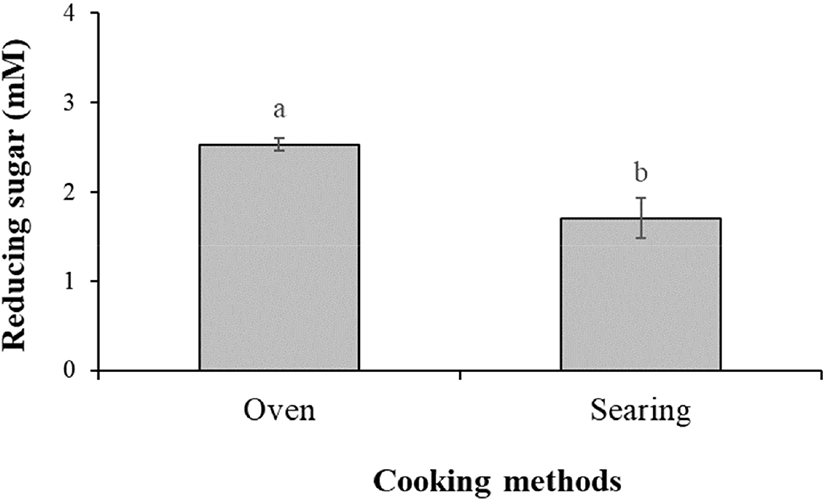
The production of flavor compounds through the Maillard reaction is determined by the cooking method, cooking time, temperature, and moisture content of meat, as well as the type of sugars and amino acids (Jousse et al., 2002). 2-Ethyl-5-methyl-pyrazine, which produces a roasted flavor among the pyrazines produced by the Maillard reaction, was approximately 5 times higher when cooked at 232°C than at 177°C (Wall et al., 2019). For these reasons, the flavor intensity of the searing treatment was higher in the sensory evaluation than oven cooking (Table 1).
In the first step of the Maillard reaction, the reducing sugars and amino acids are reacted to form non-colored compounds that are not visible (Delgado-Andrade et al., 2010). The precursor of the Maillard reaction which is produced at an intermediate stage of the non-enzymetic browning reaction could be identified at 290 nm (Ajandouz et al., 2001). The absorbance of the searing-cooked steak at 290 nm was 0.69, which was approximately twice the value of the oven-cooked steak (Fig. 5a). This result was in agreement with Sun et al. (2010) who found higher absorbance at 290 nm when cooking chicken under higher temperature conditions.
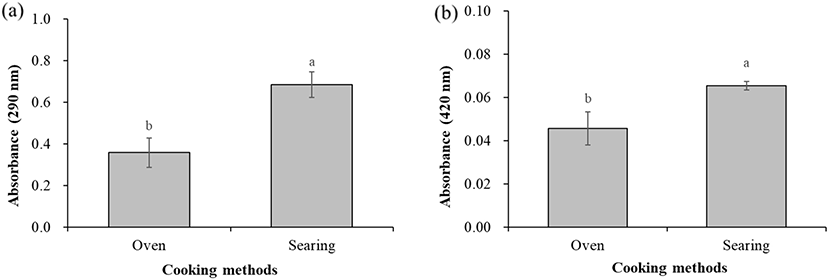
Brown color was extracted from the meat as the Maillard reaction proceeded by cooking, and the browning intensity was measured at a wavelength of 420 nm (Vhangani and Van, 2016). The Maillard reaction is temperature-dependent, and the reaction rate between the sugars and the amino groups increases with increasing temperature (Thomsen et al., 2005). Therefore, the searing cooking method, which has a 1.16-fold higher cooking rate than oven cooking, led to more frequent Maillard reaction, resulting in a higher browning intensity (0.07 vs. 0.05) than that of oven cooking (Fig. 5b). The results are similar to those obtained by Semedo et al. (2018), who reported that the absorbance at 420 nm was significantly different according to cooking method and cooking time of hairtail fillets. The authors also indicated that the yellowness of the fried sample crust decreased as increase of browning intensity.
Conclusion
Searing cooking did not affect juiciness, water content, and cooking loss of beef steaks, although it resulted in a distinct change in surface color and improved overall flavor and roasted meat aroma. Also, when the searing-cooked steak was compared with the oven-cooked steak, the significant differences were found in the reduction of reducing sugars and an increase of the Maillard reaction products. Therefore, searing may not have the ability to make beef steak juicier, as commonly thought, but only improves flavor through stronger Maillard reaction. However, in this study, there is a limitation of using only two cooking methods at a fixed temperature. Therefore, further research on cooking beef steaks with other different methods and temperatures are necessary to evaluate the effect of searing cooking.













